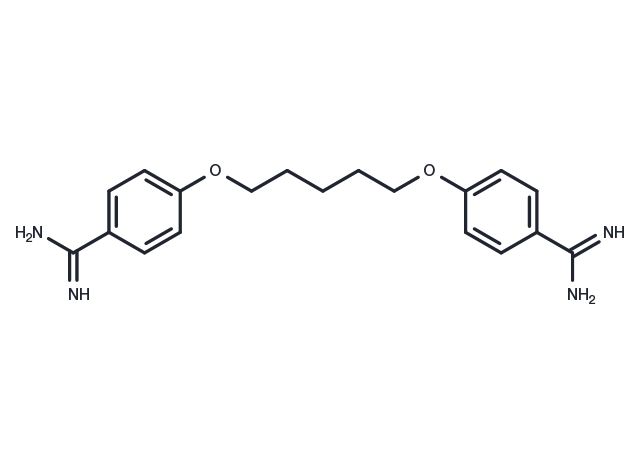Powder: -20°C for 3 years | In solvent: -80°C for 1 year


Pentamidine is an antifungal and antiprotozoal agent, interacting directly with the pathogen genome by binding to AT-rich regions of duplex DNA and the minor groove of DNA, thereby interfering with DNA replication.

| Pack Size | Availability | Price/USD | Quantity |
|---|---|---|---|
| 5 mg | In stock | $ 50.00 | |
| 200 mg | In stock | $ 275.00 | |
| 500 mg | In stock | $ 523.00 |


| Description | Pentamidine is an antifungal and antiprotozoal agent, interacting directly with the pathogen genome by binding to AT-rich regions of duplex DNA and the minor groove of DNA, thereby interfering with DNA replication. |
| Targets&IC50 | Leishmania infantum:2.5 μM (IC50) |
| In vitro | Pentamidine is effective in therapy for the hemolymphatic stage of Gambian trypanosomiasis, antimony-resistant leishmaniasis, and Pneumocystis carinii pneumonia[1]. |
| Molecular Weight | 340.42 |
| Formula | C19H24N4O2 |
| CAS No. | 100-33-4 |
Powder: -20°C for 3 years | In solvent: -80°C for 1 year
DMSO: Slightly soluble
You can also refer to dose conversion for different animals. More
bottom
Please see Inhibitor Handling Instructions for more frequently ask questions. Topics include: how to prepare stock solutions, how to store products, and cautions on cell-based assays & animal experiments, etc.
Pentamidine 100-33-4 Metabolism Microbiology/Virology Phosphatase Antifungal Parasite Antibacterial Antibiotic DNA pneumonia Fungal arrest Kidney cell-cycle carinii MP 601205 Bacterial inhibit antitumor MP601205 Pneumocystis Inhibitor biosynthetics PTP1B MP-601205 inhibitor
